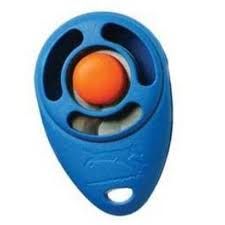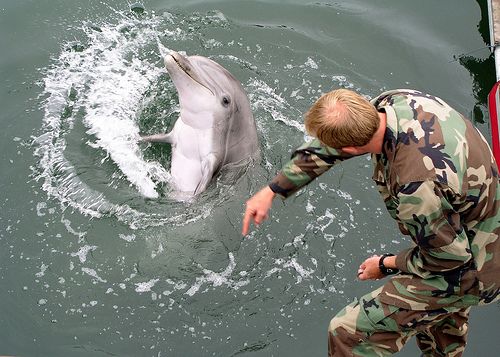Charging the clicker does not mean plugging one in! Instead, it means creating a training association to it so it can be used for animal training.
Learning how to begin clicker training, or how to charge a clicker, is laying the foundation for training an animal. This means that the animal needs to understand just what the clicker indicates.
Clicker Clarity
The clicker is used as event marker. Simply put, that means that it “marks” the behavior and signals the animal that he or she has given the desired response.
It is also used as an IOU that communicates to the animal that a reward is coming.
When you get deeper into behavior modification and the training of behaviors, the clicker itself becomes reinforcing. It becomes what is known as a conditioned reinforcer aka a secondary reinforcer.
But these terms are for those into more advanced training–what you need to know is that it is a vital communication tool to add to your arsenal.
Although you can train an animal with different markers (see this clicker training post for other options), the clicker works well because it is not associated with anything else.
Unlike your voice or specific words, the noise is unique and so can quickly and clearly communicate to the animal that he or she has responded with the correct response. (This happens once the animal understands the association.)
But to accomplish that, you have to train that association. The clicker by itself means nothing to an animal until you pair it (create an association) with something.
Ideally you pair the clicker with something of high value to the animal such as food. This process is most commonly referred to as charging the clicker.
Clicker Training Rewards
In clicker training for dogs, most people use treats but it doesn’t always have to be food, just something that is highly reinforcing to the particular critter.
The first part is to select the best reinforcer. This item should be something of high value–meaning a really, really, really desirable that the canine goes crazy for.
Something that your pet dog might be insane about could be a certain type of treat, a toy, playtime, or _?_ (You name the option.)
In this case, let’s take a look at food choices.
Dog trainers use a variety of different treats for this and some might include
- cheese,
- hot dog bits,
- freeze dried meat pieces (any sort),
- jerky treats,
- junk food treats,
- or perhaps sliced carrots.
Personally, I find that the Wellness products known as Well Bites & Pure Rewards are highly motivating commercial choices. Of course I use others but refer to these jokingly as “canine crack.” Why? Because when I did a comparison between commercial choices, most dogs loved them and would do almost anything to earn them. That is what makes them an ideal choice.
When it comes to treats in training, my main rule is this:
Animal Training Treats = Quick Flavor Burst
In this case, the idea is not to feed the dog but to give the dog a quick blast of flavor. This flavor burst rewards what just occurred and keeps the animal focused on the training and not the food.
So, with that in mind, here are my rules.
- Training treats should not require chewing.
Dry kibble, dog bones, or biscuit treats are not usually good choices because they require chewing. Freeze dried items or fresh jerky might be used, if and only if…
- Training treats should be easily broken into very small tidbits.
Break any treats down to about the size of a pea, or a single corn kernel. If you do that, just about anything can be used.
- Training treat supply should be made ready in advance of the training session.
Delays in delivering a treat after a click, or the failure to have enough treats, can mess up the training session. I like to have a lot on hand, the rest can be stored for later use.
Click N’ Charge
To “charge the clicker” there are a few rules to follow. When you are more advanced, you can shortcut, but in the beginning, here is what you need to know.
- Every click is followed by a treat.
In the beginning treat delivery is paired with each and every click. No exceptions or you create confusion.
- Use some variation in delivery and location.
I like to do specific sessions to charge the clicker. It usually means click-treat, click-treat, click-treat for a minimum number of times. Some trainers say 20 times but I gauge it by the pet. For most people, this usually occurs over multiple sessions.
Clicker Charging Cautions
When charging the clicker, it is important to vary how you deliver the treat, where you deliver the treat, and to make sure you are not reinforcing a certain behavior.
- Create the connection and don’t reward bad behavior during the process.
For instance, if the dog paws or nudges you in order to get a treat, you would need to end the session and not click or reward.
In many cases you can just click-treat, click-treat and then move off to something else and try it in another location later. Remember that you can also click right before you feed an animal or give it a treat.
To avoid trouble, be careful not to click when the animal stares only at the clicker, or only at the food.
My personal preference is to teach an animal to look into my eyes and then click. I might make noises with my mouth and click and then treat when the animal looks at me–but you don’t have to be so formal.
Instead, just make sure that you deliver the treat from different locations. For instance, sometimes you might deliver the treat from your hand, toss the treat to the dog, drop the treat on the floor, or pull it out of a pocket or out of a pouch behind your back.
If you take these precautions, you will help to reduce the focus on the delivery of the treats.
Now I also tend to use key phrases with training. One of my favorites is, “It is time for school!” This gives the animal a different indicator about a session than just grabbing a clicker.
My animal students get really excited when I ask, “Do you want to go to school?”
When the animal understands the concept, you will see a change in the dog’s interest level. Sometimes a dog will wag its tail, bark or give subtle signals–such as moving the ears forward in interest.
Training should be fun and once the clicker is charged, you will have an animal that is indeed ready to start school.
Okay, so now it is your turn. Go try this and pay attention to what is happening. Then report back.
If you are already involved in this type of process, please share how you started and just what signaled the “lightbulb moment of understanding.”



